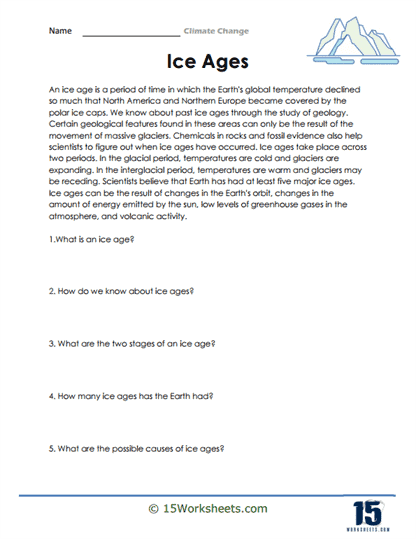Ice Ages

Worksheet Description
Students will be reading a passage and completing a series of questions. An ice age is a period of time in which the Earth’s global temperature declined so much that North America and Northern Europe became covered by the polar ice caps. We know about past ice ages through the study of geology. Certain geological features found in these areas can only be the result of the movement of massive glaciers. Chemicals in rocks and fossil evidence also help scientists to figure out when ice ages have occurred. Ice ages take place across two periods. In the glacial period, temperatures are cold and glaciers are expanding. In the interglacial period, temperatures are warm and glaciers may be receding. Scientists believe that Earth has had at least five major ice ages. Ice ages can be the result of changes in the Earth’s orbit, changes in the amount of energy emitted by the sun, low levels of greenhouse gases in the atmosphere, and volcanic activity.
The worksheet looks into the concept of ice ages, periods when Earth’s global temperatures significantly decline leading to expansive ice cover, particularly over North America and Northern Europe. It provides an informative brief on the phenomenon, explaining how ice ages can be identified through geological studies, the number of ice ages Earth has experienced, and potential triggers for these events. Accompanying the textual information are five questions tailored to gauge the reader’s understanding of the content, ranging from the basic definition of an ice age to the causes behind them. The graphic of icy mountains at the top underscores the chilly theme of the topic.
To effectively work through this worksheet, a student should start by carefully reading the provided information about ice ages, ensuring they grasp the key details and concepts. After a thorough reading, they should proceed to answer the five questions based on their comprehension of the text. If uncertain about any answers, students should revisit the corresponding section of the information provided. It may also be beneficial for students to discuss their responses with peers or research further for a comprehensive understanding, ensuring their answers are both accurate and in-depth.
The “Ice Ages” worksheet aspires to impart knowledge about a significant climatic phenomenon in Earth’s history. Through the textual brief and accompanying questions, it strives to elucidate what constitutes an ice age, methods scientists employ to identify them, their frequency in Earth’s timeline, and the possible factors instigating these events. The goal is to foster an appreciation of historical climate patterns and the complex interplay of factors that influence global temperatures. Ultimately, the worksheet is designed to enhance students’ foundational knowledge in climatology, equipping them to engage more deeply with broader topics related to climate change and Earth’s history.
